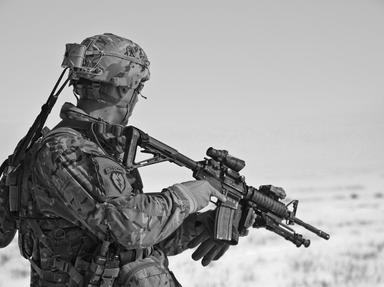Quiz Answer Key and Fun Facts
1. Classified as a fast, twin engine 'Heavy Fighter' my inaugural flight was in 1936. I enjoyed considerable initial success in my early campaigns in Poland, Norway and France, but my lack of maneuverability was highlighted during my involvement in the Battle of Britain, when up against faster, more nimble fighters like the Hurricane and Spitfire, I was outclassed and suddenly vulnerable - What am I?
2. Which German tank am I - the only one to remain in continuous production throughout the second world war with the ordnance inventory designation Sd.Kfz. 161?
3. I was originally a design from Czechoslovak and was built under license and became the British and Commonwealth forces' primary infantry LMG in World War II. What am I?
4. I was originally designed as an AA gun, but became the scourge of allied tanks. I was allegedly first used in the anti-tank role as part of the German Condor legion during the Spanish Civil War but became infamous from an Allied perspective in World War II - But what am I? (Please name the calibre of weapon)
5. I was designed in 1940 to meet a British Purchasing Commission requirement to build fighters under licence for the RAF. However, the company decided to offer a completely new fighter design instead with the first prototype flying as early as September 1940 and the RAF placed a contract the following month. Further enhancements included giving it a Merlin engine and the rest, as they say, became history. What am I?
6. I was the world's first single-stage ballistic missile with a range of over 200 km and able to deliver a payload of 910 kilograms (2,010 lb) of explosive. Over 3,172 were fired at targets throughout the UK and Western Europe - what am I?
7. My first prototype was completed on 2 September 1941 and I was rapidly brought into production began in February 1942. I became the standard tank in use with the British and American forces throughout the rest of the war and nearly 50,000 were manufactured during the war - What am I?
8. This aircraft first flew on 27th July 1937 and was originally developed as long range airliner. With the advent of war it was put into service for the Luftwaffe where it performed excellently as a long-range maritime reconnaissance and in the anti-shipping role. It was also extensively used as a transport. What am I?
9. I was main troop-carrying glider used by the British Airborne forces in World War 2 and could carry 28-30 men including jeeps and even anti-tank guns. What am I?
10. I am a biplane torpedo bomber used by the Fleet Air Arm. Designed by the Fairey Aviation Company I enjoyed remarkable success during the war and played a key role at the Battles of Taranto and also in disabling the German Battleship the Bismark. Known as the Fairy Swordfish, what was my nickname?
Source: Author
JJMcGiver
This quiz was reviewed by FunTrivia editor
stedman before going online.
Any errors found in FunTrivia content are routinely corrected through our feedback system.

